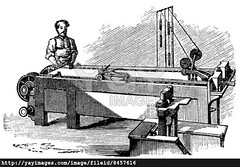
PREV ARTICLE
NEXT ARTICLE
FULL ISSUE
PREV FULL ISSUE
SPINNERET MACHINES IN NUMISMATICS
Last week a web site visitor asked about the "spinneret machine" in the context of the 1804 dollar. I was stumped. Here's what some readers had to say.
-Editor
David Lange writes:
Steve Bishop writes: I don't know what spinnerets have to do with the 1804 dollar or even coins in general, but I thought I recognized the term, so I did a quick patent search, which confirmed my initial guess. Spinnerets are used for forming filaments from viscid or viscous substances such as cellulose, by forcing of the material under pressure through one or more openings or capillary pores in the spinneret. They are used now to produce various threads and filaments out of plastic or carbon (for carbon fiber composites), but I suppose in the early nineteenth century they were used to turn cellulose into artificial silk. Robert Wimbrow writes: A spinneret is the extrusion component used by the textile industry in manufacturing synthetic fibers like nylon, rayon, polyester and acrylics. The fibers are produced using the various processes discussed on the following web site: www.fibersource.com/f-tutor/techpag.htm Nylon was the first fiber of this type that was a commercial success. It was introduced in 1939 as a substitute for silk and was used extensively by the military during World War II in such things as parachutes and clothing. Current US "paper" money employs small quantities of synthetic fibers. The bills are printed on fabric consisting primarily of a 75%/25% mix of cotton and linen. However, they also have tiny blue and red fibers of various lengths evenly distributed through the fabric as a security feature. These colored fibers were originally made of silk, but were replaced by synthetic fibers some time after nylon was introduced. These colored fibers are probably produced using a spinneret extrusion process.
To read the earlier E-Sylum article, see:
QUERY: WHAT IS A SPINNERET MACHINE?
(www.coinbooks.org/esylum_v16n39a16.html)
The Numismatic Bibliomania Society is a non-profit organization promoting numismatic literature. See our web site at coinbooks.org. To submit items for publication in The E-Sylum, write to the Editor at this address: whomren@gmail.com To subscribe go to: https://my.binhost.com/lists/listinfo/esylum All Rights Reserved. NBS Home Page Contact the NBS webmaster 
|
